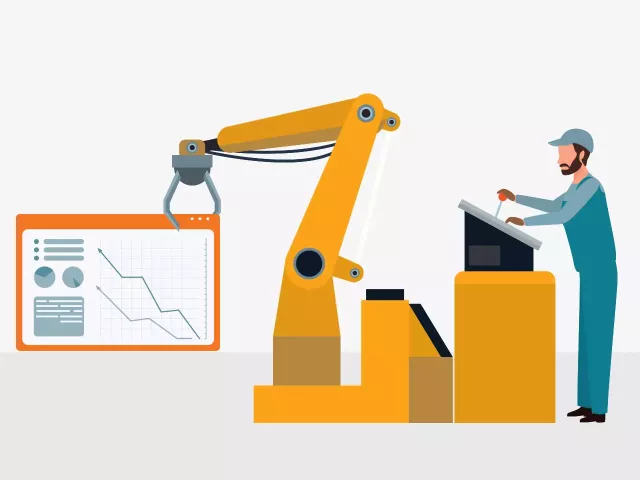Future-readiness is about making sure the people, processes, data, and technology of your company are all aligned. When they are, you can pivot and change strategy with minimal disruption and even capitalize on market opportunities. Instead of playing catch up when markets change (reactive), future-ready leaders focus their energy on long-term performance and solutions (proactive).
A recent report published by Salesforce stated that future-ready manufacturers have a greater ability to sense change in the market and are able to respond faster.1 This means that changing consumer needs, combined with shifting workforce expectations, are altering the way companies compete. As consumer needs continue to rapidly evolve over the next 10 years, current operating models must adapt and be prepared for a variety of disruptors.1
To better understand what that means, I spoke with Michael Janney, Salesforce’s Vice President-Manufacturing Industry Advisor. During that conversation, Michael and I discussed the pandemic's lasting effects on the industry and what it will take to succeed in the coming decade—aka how to become a future-ready enterprise.
Below are video excerpts from the conversation recorded on LinkedIn Live.
Three Ways Manufacturers can Become Future-Ready
1. Combining data and collaboration in your sales processes
Future-ready companies are turning their investments inward in order to build a stronger, more collaborative work environment centered around data transparency. This is where employee engagement and collaboration along the value chain comes into play.
How can we leverage data upfront in the sales process and how can we leverage and collaborate efficiently with that data especially when it gets to the plant floor for production
How can you do this?
In order to make real-time decisions to keep the business on track, leaders need easy and instant access to data that is up-to-date, accurate, and comprehensive. An easy first step is getting a clear understanding of the quality of your sales data. You need to make sure you have the best information available to your organization because that data is used to analyze performance, identify reps at risk for attrition, and improve sales forecasting accuracy.
2. Building agility and adaptability so you’re prepared for the ‘what if’
Organizations need to build agility and adaptability into their operations so they can be prepared for the ‘what if’. Being prepared can be as easy as:
- Adopting new business strategies
- Emphasizing team communication
- Being in-tune with emerging industry trends and technology
How can you do this?
Start by taking a look at your internal processes and making sure you have a full-scope view of your operations. From there, take a closer look at your sales forecasting capabilities. You need to make sure you have a tool that enables you to accelerate your reaction time to market disruptions and improves decision-making abilities. The ability to conduct scenario modeling and what-if analyses are crucial to increasing agility.
3. Moving towards a “Subscription Economy”
Servitization, for manufacturers, is the push to move away from one-off sales by offering services in addition to their traditional products such as maintenance, new parts, or customer service. This usually comes in the form of a subscription model.
The sales process doesn’t end at product purchase. Salesforce has uncovered that the future of manufacturing is focused on extending products’ total lifecycle value, factoring in the cost of the machine itself (as well as the number of years of aftermarket parts), tech services, and monitoring services.1 Future-ready manufacturers are leaning on aftermarket services as an important piece of their value proposition.
How can you do this?
After the sale is made, take a look at your offerings and tap into the customer’s mindset. When manufacturers add service components to their company, they open up new ways to generate value to customers and to themselves. It’s all about turning your product into a service. This can help you understand how efficiently customers are using your products, when the product is nearing a breakdown, and what you can do from a customer service standpoint to make the lifespan of your product (and your customer) longer.
Next Steps for You in the Future-Ready Process:
It is time to rethink the way businesses organize and run their operations. You can do this by creating an environment where the people, processes, and technology of your business work in lockstep. This can be achieved through intelligent sales forecasting.
81 percent of manufacturers say they need both new approaches and new tools for accurate forecasting.1
To make their business operations more resilient, future-ready enterprises are investing in intelligent software and adopting an agile mindset. Visibility into sales data is imperative to navigate a turbulent market and to make smart decisions informed by objective analytics. Sales forecasting helps leaders take a deeper look into their pipeline and their revenue operations. By analyzing sales activities, manufacturing leaders understand when and where to introduce additional processes, resources, data, strategies, and tactics that have an impact across the entire organization.
Interested in learning more about how accurate sales forecasting can be your smartest investment towards future-readiness, watch the full LinkedIn Live session, “Why Manufacturing Needs to Say Bye-Bye to Traditional Forecasting.”
Sources:


